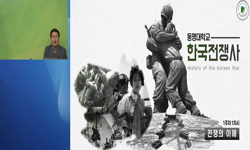This study analyzes artworks related to the Korean War to explore how war-related art functions not merely as documentation, but as a medium for expressing, transforming, and ultimately healing trauma. The Korean War was not merely a military conflict...
http://chineseinput.net/에서 pinyin(병음)방식으로 중국어를 변환할 수 있습니다.
변환된 중국어를 복사하여 사용하시면 됩니다.
- 中文 을 입력하시려면 zhongwen을 입력하시고 space를누르시면됩니다.
- 北京 을 입력하시려면 beijing을 입력하시고 space를 누르시면 됩니다.

한국전쟁과 미술 : 트라우마의 형상화와 승화 -한국 근대 미술을 중심으로- = Korean War and Fine Art : The Representation and Sublimation of Trauma -focusing on modern Korean fine art-
한글로보기https://www.riss.kr/link?id=A109691910
-
저자
선영현 (전남대학교)
- 발행기관
- 학술지명
- 권호사항
-
발행연도
2025
-
작성언어
Korean
-
주제어
war trauma ; war art ; Korean war ; PTSD ; PTG ; 전쟁 트라우마 ; 전쟁 미술 ; 한국전쟁 ; 외상 후 스트레스 장애 ; 외상 후 성장
-
등재정보
KCI등재
-
자료형태
학술저널
- 발행기관 URL
-
수록면
237-250(14쪽)
- DOI식별코드
- 제공처
-
0
상세조회 -
0
다운로드
부가정보
다국어 초록 (Multilingual Abstract)
This study analyzes artworks related to the Korean War to explore how war-related art functions not merely as documentation, but as a medium for expressing, transforming, and ultimately healing trauma. The Korean War was not merely a military conflict; it left profound psychological scars on both individuals and communities. The visual representation of these traumatic experiences has served as a crucial medium for interpreting and sharing the memories of war. Applying psychoanalytic theory and concepts of Post-Traumatic Stress Disorder (PTSD), this study examines how trauma is expressed and reenacted through repetition compulsion in war-related artworks. Furthermore, by incorporating the concept of Post-Traumatic Growth (PTG), it investigates how trauma is artistically transformed and sublimated through visual art. The analysis focuses on artists who directly experienced the war, those who lived as refugees, and those who observed the Korean War from an external perspective. These different perspectives offer a multifaceted view of how trauma is processed and represented across various socio-historical contexts. Korean War art powerfully visualizes the horrors and psychological impacts of war while simultaneously conveying the possibility of recovery and hope. Particularly, this research demonstrates how individual and collective trauma caused by war can be reinterpreted and resolved through artistic practice, thereby functioning as a means of psychological healing. It also emphasizes how visual art acts as a bridge between personal memory and collective historical consciousness, linking past suffering with future resilience. This study highlights the role of visual art not only in recording historical events but also in mediating collective memory and emotional recovery. It suggests that war-related art serves as a cultural medium through which trauma is recontextualized and transformed into a narrative of resilience. Moreover, the implications extend to contemporary conflicts, reaffirming the relevance of art as a powerful tool for both remembrance and healing in modern societies.
동일학술지(권/호) 다른 논문
-
CSR 광고의 주제 및 타이포그래피 디자인이 소비자 행동에 미치는 영향 -브랜드 신뢰의 매개 효과를 중심으로-
- 한국기초조형학회
- 왕치어
- 2025
- KCI등재
-
- 한국기초조형학회
- 임소영
- 2025
- KCI등재
-
해외 텍스타일디자인 관련 분야 공모전과 수상작 분석에 관한 연구
- 한국기초조형학회
- 채지혜
- 2025
- KCI등재
-
장애인 복지시설 환경개선 사례분석에 의한 컬러유니버설디자인(CUD) 색채 가이드라인 연구
- 한국기초조형학회
- 이상희
- 2025
- KCI등재




 KCI
KCI DBpia
DBpia






